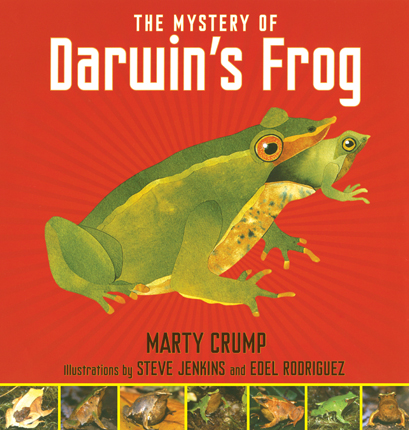Full Text Reviews: Bulletin for the Center... - 06/01/2013 Among the wonders collected by naturalist Charles Darwin on his famed voyage aboard the Beagle is a creature that’s kept scientists guessing since the mid-nineteenth century. It’s not just Rhinoderma darwinii’s Pinocchio-like snout, or its variety of skin colors, or its teeny inch-long size, but rather its outré breeding habits. The female frog contributes the customary clutch of eggs for fertilization, but then the male takes over by brooding the newly hatched tadpoles in his vocal sacs and “burping” them loose a couple of weeks later as fingernail-sized baby frogs. Crump, who has herself studied the frogs and written about them for the academic community, focuses not only on the oddities of the frogs, but also on early misunderstandings of their physiology (the presence of tadpoles within a frog’s body once led scientists to believe the brooders were female) and even the broader scientific shift from merely describing species to actually investigating their behavior. Illustrations here represent the best of two worlds-clear photography allows readers to examine the animals in natural settings, while scientific rendering, in this case not Audubon-style drawing but Jenkins’ detailed paper collage, provides objectified detail. The somewhat cramped typeface makes this offering appear a bit daunting, but readers who plunge right in should quickly discover that the writing is clear and the concepts accessible. End matter is substantive and thoughtfully arranged, from the additional notes on Darwin’s frogs, to the glossary, resource lists of children’s and adults materials, and index. EB - Copyright 2013 The Board of Trustees of the University of Illinois. School Library Journal - 04/20/2013 Gr 5–7—Most frog species give parenting the go-bye after egg-laying and fertilization, but a select number of these amphibious hoppers take their nurturing skills seriously. One of these "caring" species is Rhinoderma darwinii, an inch-long frog discovered by Charles Darwin in Chile in 1834, while on his expedition aboard the Beagle. Other scientists investigated little Rhinoderma from time to time over the years, discovering that the males slurp up their almost-hatched or newly hatched tadpoles, brood them in their vocal sacs, and perhaps even feed them with substances released by the lining of the sac. Crump entered the Rhinoderma arena of investigation after years of work on other South American frog species, and in clear, readable prose she describes the earlier investigations of this intriguing frog and records her own efforts to document how it lives in the wild. She discusses her findings and goes on to present the problems facing not only Darwin's frogs, but also frogs in general-loss of habitat, pollution, and the assault of the lethal Bd fungus. The book is aglow with clear color photos and some great artwork. Team this with Laurence Pringle's fine Frogs! Strange and Wonderful (Boyds Mills, 2012), Nic Bishop's colorful Frogs (Scholastic, 2008), and Mark W. Moffett's eye-catching Face to Face with Frogs (National Geographic, 2008) for a fascinating unit, or, for more advanced frog lovers, with Sandra Markle's sterling The Case of the Vanishing Golden Frogs (Millbrook, 2012) and Pamela Turner's superb The Frog Scientist (Houghton, 2009). Eye-catching and thought-provoking.—Patricia Manning, formerly at Eastchester Public Library, NY - Copyright 2013 Publishers Weekly, Library Journal and/or School Library Journal used with permission. Booklist - 06/01/2013 Scientist Crump introduces Darwin’s frog, a species collected by Charles Darwin, though he knew nothing of their most surprising behavioral characteristic. Once the female lays eggs, she wanders off. The male takes over by fertilizing the eggs, protecting them, and, once the tadpoles hatch, slurping them into his vocal sac, where they develop for two months before they emerge from his mouth as tiny frogs. It has taken generations to solve various mysteries surrounding Darwin’s frogs, but now scientists face a more urgent question: Why is the species disappearing? The many color illustrations include helpful photos from several sources (including Crump); handsome cut-paper collages by Jenkins; and portrait drawings, silhouettes, and maps by Rodriguez. Clearly written and informative, this colorful book takes readers along as Crump studies the frogs in Chile and discusses their disappearing habitat as well as the virus that may be killing them. The book’s historical perspective offers insight into science as an approach and a process rather than a body of knowledge. A fine addition to the science shelves. - Copyright 2013 Booklist. Loading...
|



